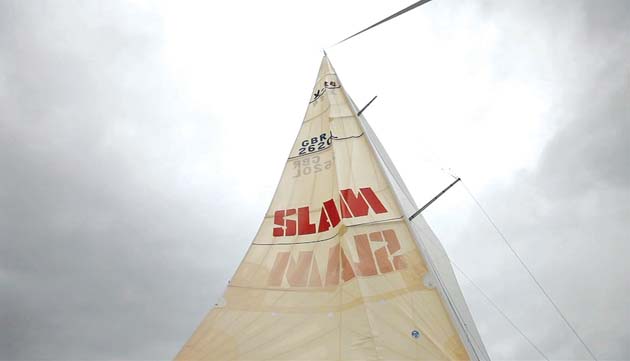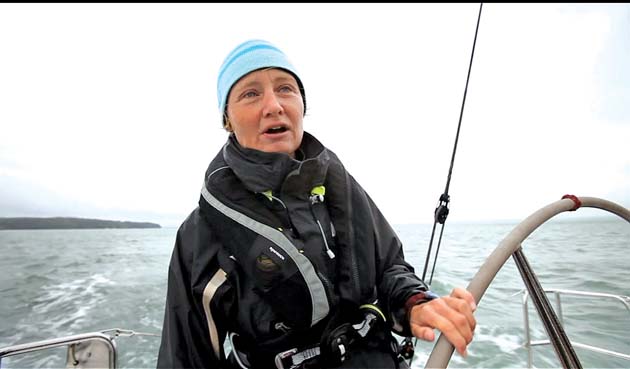In the second part of our 12-part series on advanced sailing techniques, professional sailor and coach Pip Hare guides you through what to do when you start to broach
![]()
Most of us will be familiar with that final pull on the helm that cannot be overcome as the boat rounds up to windward in a massive broach. The ensuing chaos can be hard to recover from, and damaging both for the boat and for crew morale.
Well-trimmed sails and keeping a close eye on conditions can help to avoid a lot of broaching situations. However, in this article and the accompanying video online I have drawn on my own experiences, both during solo ocean racing and when coaching mixed ability crews inshore, to highlight some key points on how to recognise the early warning signs of a broach.
See our video of SAIL FASTER SAIL SAFER Part 2
I look here at how to trim the sails to avoid losing control, as well as steering, crew interaction, what to do at night and when you are sailing short-handed.
Mainsail
Prompt action with mainsail trim can often be the simple answer to stop a tug on the helm from becoming a full wipe-out. On the first signs of a broach a quick ease of the kicker will twist off the top of the sail and so reduce the heeling moment.
When reaching in gusty conditions, the mainsail should always be well eased, traveller down, with a backwind ‘bubble’ at the mast as the default trim.
Make sure the kicker is in easy reach and if you are struggling to steer, place a crewmember next to it. If you often sail short-handed, think about leading the kicker to a position in the cockpit where it is more accessible. Double-ended systems are ideal.
If releasing the kicker does not reduce sufficient pressure on the helm, release the mainsheet until the boat comes back upright. All these actions will need to be done in quick succession, and as always it is good practice to make sure your mainsheet is kept flaked and ready to run out.
If you continually need to ease the main, then it is maybe time to reef; shortening the mainsail can make the boat easier to manage with less heel and often an insignificant loss of speed.
Spinnaker
Broaching can occur under any sail plan; it is not a spinnaker-specific occurrence, though having the spinnaker up can make it a more intimidating experience.
If the mainsail cannot be depowered enough to prevent a broach, the spinnaker sheet is the only remaining ‘get out of jail’ line.
Top tips for short-handing
Make sure all the crucial lines – kicker, mainsheet and spinnaker sheet – are within easy reach of the helm. Cross-winch across the cockpit if necessary.
Put some luminous tape on the wheel so at night you can tell at a glance how much helm the autopilot is using.
Immediately ease out a large amount of spinnaker sheet until you feel the boat start to come upright or the helmsman tells you they have feeling back in the rudder. If you are using a lazy guy, ensure this will not catch on anything or prevent an ease.
Keep the spinnaker sheet eased until the boat is upright and starting to get back on course – an insufficient dump of the spinnaker sheet or bringing it back on too early will cause the boat to roll straight back into a broach every time it tries to recover.
When reaching under spinnaker be very sure not to let out the guy. This will make the situation worse as the pole will crash onto the forestay and the spinnaker will slew to leeward, heeling the boat even more.
A constant need to ease the spinnaker is probably an indication that it is time to take it down. As always, have the halyard flaked, ready to run and be ready to drop.
Steering
A broach can be averted by good communication between helmsman and crew. A first indication of a broach will be a marked increase in weather helm which it is difficult to steer against; at this point the helmsman must involve the crew.
The crew will not always know exactly how much kicker or sheet to let off and when, so to avoid all sails being dumped every time the boat heels over, the helmsman must keep the crew informed.
If, despite easing sheets, the boat continues to broach, pump the helm by bearing away hard, steering straight, then bearing away hard again. However, if you do not regain control you will get to a point where that is no longer effective. At this point, try putting the helm back to centre. With eased sheets and a little patience the boat should come upright and start to move forward, water will start flowing over the rudder and you will be able to steer downwind to avoid another broach.
If you are continually having to ease the sheet to avoid a broach, try steering a little lower or changing your sail plan.
Depower the main:

Ease the sheet:

Steer downwind:

Trim sails to pilot:

Under autopilot
Autopilots are particularly sensitive to gusts and waves when reaching and so a change in conditions can cause the pilot to broach quite easily.
Keep an eye on how hard your pilot is working. As conditions worsen, increase response level to help it cope.
Trim the sails to the pilot and not the other way around. Think about taking in a reef earlier when using the pilot in potential broaching conditions – remember, it is not able to tell you to release the kicker.
Do’s and don’ts
- DO stay calm and keep talking
- DO ensure sheets are flaked and ready to run out
- DO practise reaching in gusty conditions to learn how quickly your boat responds
- DON’T shout
- DON’T ease the guy
- Be ready to reduce sail before you stop enjoying sailing
 Single-handed ocean sailor Pip Hare has clocked up thousands of miles racing and cruising. Among her achievements are five solo transatlantics, including the OSTAR and two Mini Transat races. She also works full-time for the RNLI on sea safety and is Consulting Editor on Yachting World. See also her series on short-handed sailing
Single-handed ocean sailor Pip Hare has clocked up thousands of miles racing and cruising. Among her achievements are five solo transatlantics, including the OSTAR and two Mini Transat races. She also works full-time for the RNLI on sea safety and is Consulting Editor on Yachting World. See also her series on short-handed sailing
SAIL FASTER SAIL SAFER Part 3: Pip Hare describes how to gybe a spinnaker successfully
12 part series in association with Pantaenius




